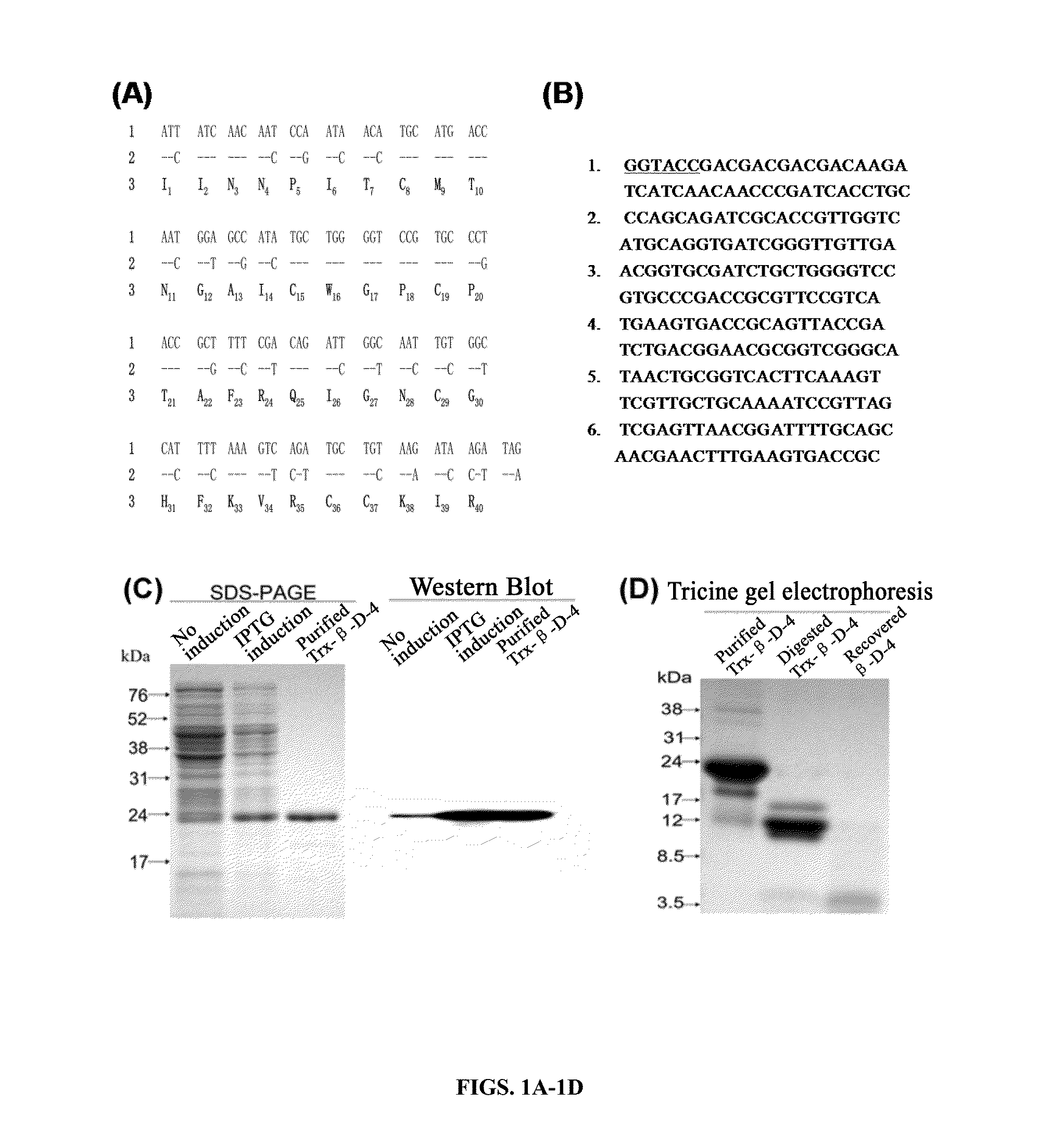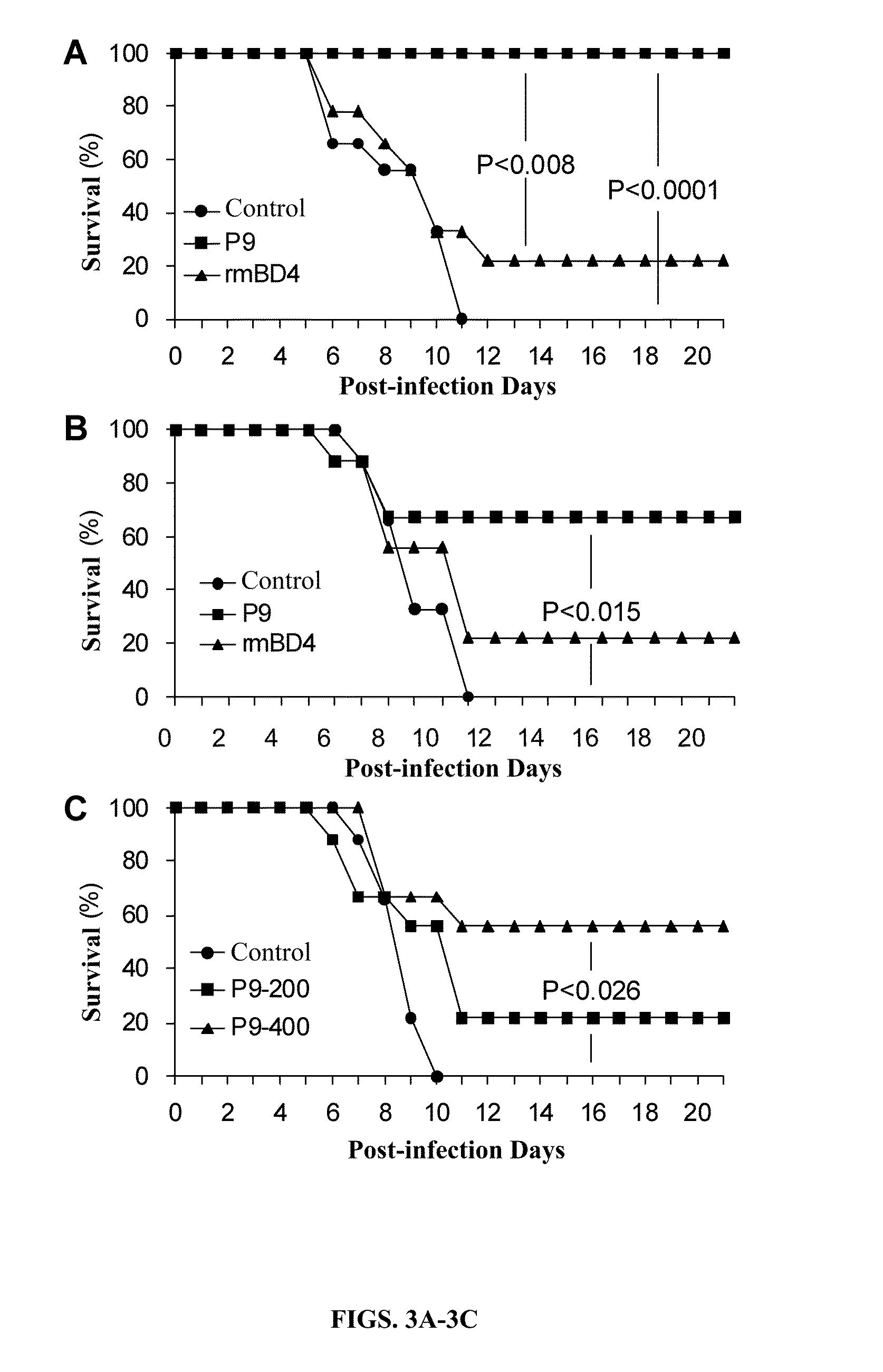Peptides Having Activity of Inhibiting Infections of Respiratory Viruses and Use of the Same
a technology of respiratory viruses and peptides, which is applied in the field of antiviral prophylaxis and therapy, can solve the problems of affecting the development of defensins as therapeutics, the inability to cost-effectively manufacture defensins, and the largely unknown antiviral mechanism of amps, so as to inhibit the decrease of ph and achieve potent activity.
- Summary
- Abstract
- Description
- Claims
- Application Information
AI Technical Summary
Benefits of technology
Problems solved by technology
Method used
Image
Examples
experimental example 1
The Antiviral Peptide P9 Exhibited the Highest Antiviral Activity in Cultured Cells
[0106]Eleven mBD4-derived peptides were designed and synthesized (Table 1). Antiviral effects of smBD4, rmBD4 and 11 peptides derived from mBD4 (Table 1) were detected against the infection of influenza A virus (H1N1) in cell cultures. Compared to the full-length synthetic mBD4 (smBD4) and recombinant mBD4 (rmBD4), a short peptide P9 (30 amino acids) exhibited the potent and dose-dependent antiviral activity, while the other short peptides showed median or no antiviral effects (FIG. 2). In FIG. 2A, H1N1 virus was pre-incubated respectively with the short peptides and positive controls (i.e., smBD4 and rmBD4) at room temperature (RT) for 1 hour, and then was inoculated to MDCK cells. The inhibitory effects to the viral infection were detected by plaque assay. The infection ratio was calculated as the plaque number of virus pretreated with a peptide being divided by the plaque number of virus pretreated...
experimental example 2
The P9 Showed Much Potent Protective Effects Against Lethal Challenge of H1N1 Influenza Virus
[0107]Prophylactic and therapeutic effects of the P9 were evaluated in lethal infection animal model of H1N1 influenza virus (FIG. 3). When the mice were i.n. inoculated with the P9 or rmBD4 before they were i.n. inoculated with lethal dose of the virus, the survival rate of the P9-treated mice was 100% (9 / 9), which was significantly higher than that of rmBD4-treated mice (22% (2 / 9)) (P 0.05).
[0108]The virus RNA copies and viral titers in lung tissues of mice receiving prophylactic treatment, i.n. therapy or i.p. therapy were detected by real-time RT-PCR (FIG. 4A) and plaque assay (FIG. 4B), respectively. The results showed that the viral loads in lung tissues of P9-pretreated and i.n. or i.p. P9-treated mice were significantly lower than those of the untreated mice (P <0.05). Histopathological changes in lung tissues were examined by H&E staining, which showed that the alveolar damage and i...
experimental example 3
The P9 Inhibited Influenza Virus Infection Through Binding to Viral Surface Glycoprotein HA
[0109]To investigate how the P9 inhibited the virus infection, the P9 was used for pretreating the MDCK cells or H1N1 virus before viral infection, or was just supplemented in the cell culture medium after the viral infection. In FIGS. 5A, 5D and 5G, MDCK cells were infected with the virus at MOI of 0.3 and then cultured in the presence of the P9 (25 μg / ml) (indicated by P9-maint). In FIGS. 5B, 5E and 5H, the cells were pretreated with the P9 (25 μg / ml) for 1 hour and then infected with 0.3 MOI of the virus (indicated by P9-cell-pre). In FIGS. 5C, 5F and 5I, the virus (0.3 MOI) was pretreated with the P9 (25 μg / m1) for 1 hour and then inoculated to the cells (indicated by P9-virus-pre). The viral loads inside the infected cells (FIGS. 5A, 5B and 5C) and in cell culture supernatants (FIGS. 5D, 5E and 5F) were determined by real-time RT-PCR, while the titers of infectious virus in supernatants w...
PUM
| Property | Measurement | Unit |
|---|---|---|
| Fraction | aaaaa | aaaaa |
| Fraction | aaaaa | aaaaa |
| Fraction | aaaaa | aaaaa |
Abstract
Description
Claims
Application Information
 Login to View More
Login to View More - R&D
- Intellectual Property
- Life Sciences
- Materials
- Tech Scout
- Unparalleled Data Quality
- Higher Quality Content
- 60% Fewer Hallucinations
Browse by: Latest US Patents, China's latest patents, Technical Efficacy Thesaurus, Application Domain, Technology Topic, Popular Technical Reports.
© 2025 PatSnap. All rights reserved.Legal|Privacy policy|Modern Slavery Act Transparency Statement|Sitemap|About US| Contact US: help@patsnap.com



